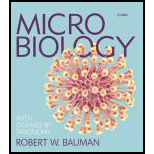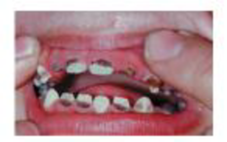
Concept explainers
Culturing Microorganisms
One of Koch’s postulates for demonstrating that a certain agent causes a specific disease requires that microorganisms be isolated and cultivated (Chapter 1). Medical laboratory personnel must also grow pathogens as a step in the diagnosis of many diseases. To cultivate or culture microorganisms, a sample called an inoculum (plural: inocula) is introduced into a collection of
Clinical Case Study Cavities Gone Wild

Five-year-old Daniel appears to be shy. He always looks at the floor, has no friends, never plays with the other children, and will rarely speak to adults. When he does speak, it is difficult to understand his broken enunciation. His skinny frame and the dark circles under his eyes make him appear malnourished. Daniel cries frequently and misses many days of school.
A speech specialist at school finds that only two of Daniel’s teeth are healthy; all the others have rotted away to the gum line. The little guy is in constant pain, and it hurts to chew. A doctor later determines that bacteria from the cavities in his mouth have entered his bloodstream and infected his heart, causing an irregular heartbeat and poor blood circulation.
- 1. How does knowledge of biofilms help explain the bulk of Daniel’s problems?
- 2. What can Daniel, his parents, and health care professionals do to cure his diseases?
- 3. What is the scientific name of the nutrient that Daniel’s parents should eliminate from his diet to help prevent a repeat of this condition?
- 4. A recent study has shown that brushing does more than clean plaque from the teeth; it also disrupts associations between oral bacteria. How does this simple act help prevent the formation of biofilms?
Want to see the full answer?
Check out a sample textbook solution
Chapter 6 Solutions
Microbiology with Diseases by Taxonomy (5th Edition)
- What is the opening indicated by the pointer? (leaf x.s.) stomate guard cell lenticel intercellular space none of thesearrow_forwardIdentify the indicated tissue? (stem x.s.) parenchyma collenchyma sclerenchyma ○ xylem ○ phloem none of thesearrow_forwardWhere did this structure originate from? (Salix branch root) epidermis cortex endodermis pericycle vascular cylinderarrow_forward
- Identify the indicated tissue. (Tilia stem x.s.) parenchyma collenchyma sclerenchyma xylem phloem none of thesearrow_forwardIdentify the indicated structure. (Cucurbita stem l.s.) pit lenticel stomate tendril none of thesearrow_forwardIdentify the specific cell? (Zebrina leaf peel) vessel element sieve element companion cell tracheid guard cell subsidiary cell none of thesearrow_forward
- What type of cells flank the opening on either side? (leaf x.s.) vessel elements sieve elements companion cells tracheids guard cells none of thesearrow_forwardWhat specific cell is indicated. (Cucurbita stem I.s.) vessel element sieve element O companion cell tracheid guard cell none of thesearrow_forwardWhat specific cell is indicated? (Aristolochia stem x.s.) vessel element sieve element ○ companion cell O O O O O tracheid O guard cell none of thesearrow_forward
- Identify the tissue. parenchyma collenchyma sclerenchyma ○ xylem O phloem O none of thesearrow_forwardPlease answer q3arrow_forwardRespond to the following in a minimum of 175 words: How might CRISPR-Cas 9 be used in research or, eventually, therapeutically in patients? What are some potential ethical issues associated with using this technology? Do the advantages of using this technology outweigh the disadvantages (or vice versa)? Explain your position.arrow_forward
 Medical Terminology for Health Professions, Spira...Health & NutritionISBN:9781305634350Author:Ann Ehrlich, Carol L. Schroeder, Laura Ehrlich, Katrina A. SchroederPublisher:Cengage Learning
Medical Terminology for Health Professions, Spira...Health & NutritionISBN:9781305634350Author:Ann Ehrlich, Carol L. Schroeder, Laura Ehrlich, Katrina A. SchroederPublisher:Cengage Learning Biology: The Dynamic Science (MindTap Course List)BiologyISBN:9781305389892Author:Peter J. Russell, Paul E. Hertz, Beverly McMillanPublisher:Cengage Learning
Biology: The Dynamic Science (MindTap Course List)BiologyISBN:9781305389892Author:Peter J. Russell, Paul E. Hertz, Beverly McMillanPublisher:Cengage Learning





